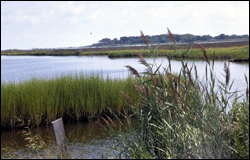Thrive Again?
Confront
the Bay's
Complexity
Contents
A Non-Native Oyster: Assessing a Potential Introduction

|

|

|
|
|
Two modelers, one Bay. Elizabeth North (top left) uses models to help decision makers tackle the tough issue of whether to introduce a non-native oyster to the Bay. Bob Ulanowicz (top right) has pioneered the field of ecological network analysis to help explain the complex food web that drives the Chesapeake. Restoring oysters to the Bay could boost the oyster fishery and also improve the overall health of the estuary. Photographs: North by Skip Brown; Ulanowicz by Erica Goldman; Marsh by Sandy Rodgers.
|
|
Can you remember the first time you glimpsed the night sky, without the haze of streetlights, and realized that the number of stars so vastly surpassed your expectations? Or the first time you peered through the lens of a microscope to discover that a simple sheath of onion skin actually contains dozens and dozens of translucent cells, all lined up like dominoes?
Maybe it was something else for you. An abrupt feeling of smallness while hiking among tall trees, or a sudden sense of humility out on a small boat in building waves. Each of us has undoubtedly experienced moments of quiet wonder at nature's intricacy and power, in ways highly personal.
Much of the pursuit of science through human history emerges from our desire to augment this sense of awe with an understanding of nature's complexity. And lately, we've become better and better at tackling the large-scale questions.
As our capabilities for computation have improved, we've developed more sophisticated tools for predicting snowstorms and hurricanes. We've gained great insight into complex ecosystems like the Chesapeake Bay, amassing clues to what makes such systems function and what makes them falter.
Mathematical models serve as one powerful tool in our pursuit to make sense of the world's infinite complexity. Models enable us to hold a "mirror up to nature," to borrow from Shakespeare's Hamlet. They reflect reality, but simplify it to a form that computers can digest and the human mind can comprehend.
Models can help us understand how systems are put together. On an intellectual level, they can help clarify complex processes, from climate to cancer. On a practical level, they can inform immediate, real-life choices — anything from a city's decision to marshal its fleet of snowplows in advance of a storm to public health officials' ability to monitor a feared flu pandemic.
To match the right tool with the right problem, modelers rely on all flavors of mathematics. In the Chesapeake Bay community alone, their efforts run the gamut in scope. Models address questions that range from process-specific, such as how bacteria cycle nitrogen, to big-picture, such as how the whole Chesapeake watershed might respond to changes in land use, pollution, or nutrient reduction efforts.
In this issue of Chesapeake Quarterly, you will read about two very different modeling efforts and meet two very different modelers. First, you will learn about the efforts of Elizabeth North, a young scientist at the Horn Point Laboratory of the University of Maryland Center for Environmental Science (UMCES). She is conducting research to help policy makers in Maryland and Virginia as they decide whether to introduce the non-native oyster, Crassostrea ariakensis, to the estuary. The larval transport model developed by North and her colleagues falls into the practical category. It will assist resource managers directly, predicting the patterns of larval settlement on reefs throughout the Chesapeake to help them evaluate different scenarios for restoring oysters to the Bay.
Next, you will meet modeler (and philosopher) Bob Ulanowicz — a scientist nearing the end of his long and distinguished academic career at the UMCES Chesapeake Biological Laboratory. Ulanowicz's models fall into the more theoretical category, providing a unified framework for understanding how the Chesapeake Bay functions as a whole and how it has evolved over time. Using a technique called network analysis to model the Bay's food web, Ulanowicz's models provide a first principle approach that can be tailored to any complex ecosystem. Today, many practical models for resource management, such as multi-species fisheries models, employ Ulanowicz's theoretical basis at their core.
Models do not predict the future. They are not crystal balls. As human constructs they merely confer a greater ability to penetrate new scales of observation, to make sense of an intricate universe.
Let yourself think like a modeler for a moment. When you next confront nature's complexity — whether the countless stars overhead or the baffling "who-eats-whom"makeup of the Bay's food web — pause for a second and ask what it would take to understand how these things work. Where would you begin? Read more . . .
![[Maryland Sea Grant]](/GIFs/h_footer_mdsg.gif)